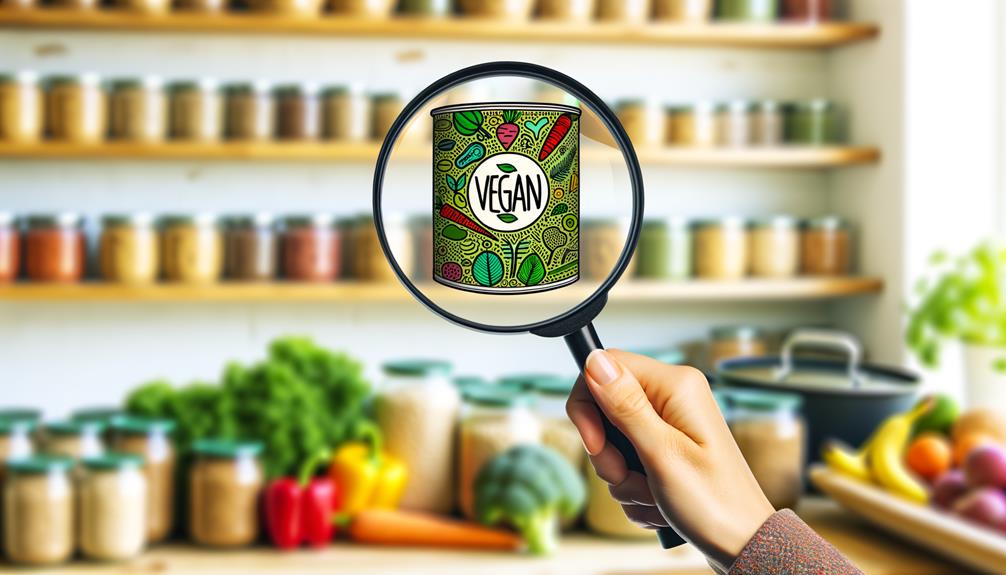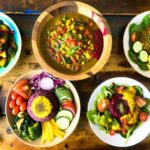Is it true that every food product labeled as ‘vegan’ is completely free from animal-derived ingredients? You might think so, but in reality, the world of vegan food labelling can be a bit of a labyrinth. As you navigate your way to a healthier, more ethical lifestyle, it’s crucial to know how to decode these food labels effectively. You see, not all products marketed as vegan are created equal, and some can sneak in non-vegan ingredients under the guise of complex chemical names or misleading labeling practices. So, how do you ensure what you’re consuming is genuinely vegan? That’s something we’re about to explore.
Key Takeaways
- Gelatin, casein, and whey are common animal-derived additives that can be hidden in ingredient lists.
- Reading and understanding nutritional information on food labels can help make informed dietary choices.
- Hidden animal derivatives can be detected by carefully reading ingredient lists and staying updated on food labeling regulations.
- Recognizing and relying on vegan certifications ensures that products align with ethical standards and are free from animal ingredients.
Identifying Non-Vegan Ingredients
Navigating the world of vegan food labels can be tricky, with animal-derived additives like gelatin, casein, and whey often hidden in ingredient lists. These seemingly innocent substances are common animal-derived additives that can trip up even the most vigilant vegan. Gelatin, for example, is derived from animal bones and skin, while casein and whey are both products of the dairy industry.
So, what’s the secret to outsmarting these hidden animal derivatives? First, arm yourself with knowledge. Recognize the common culprits and look for them on ingredient lists. Then, apply some handy tips for avoiding these hidden foes.
Always read food labels thoroughly. This can’t be stressed enough. Even products marketed as ‘plant-based’ might contain non-vegan components. It’s also a good idea to opt for foods certified as vegan. These products have been scrutinized for you, ensuring they’re truly free of animal derivatives.
Understanding Nutritional Information
While sidestepping non-vegan ingredients is crucial, it’s equally important to understand the nutritional information on food labels to ensure you’re meeting your dietary needs. This information provides insights into portion sizes and nutrient content, two key factors in maintaining a balanced diet.
By becoming familiar with nutritional labels, you’re equipping yourself with the knowledge to make informed dietary choices. This information allows you to identify essential vitamins, minerals, and macronutrient values. You can then compare products and select those that align with your dietary needs and wellness goals.
Understanding this information isn’t just about personal health, though. It’s also about community health. You’re not just serving yourself by making conscious decisions about food purchases, you’re serving others. By investing in nutrient-rich, vegan products, you’re supporting businesses that prioritize both health and ethical practices.
In essence, taking the time to understand nutritional information on food labels supports your overall well-being and contributes to a healthier and more compassionate world. So next time you shop, don’t just glance at the label, study it. Your body, the animals, and the planet will thank you.
Detecting Hidden Animal Derivatives
Just as important as understanding nutritional information is being able to detect hidden animal derivatives in your food. Careful reading of ingredient lists is crucial. Look out for terms like gelatin, casein, whey, albumin, and lactose which are common animal-derived additives.
You must also stay updated on changes in food labeling regulations. Exploring alternative plant-based ingredients can be a fun and informative part of your vegan journey. There are countless vegan-certified or plant-based alternatives available to avoid animal derivatives.
When dining out, tips for navigating restaurant menus include asking about specific ingredients and preparation methods. Even dishes labeled as “vegetarian” may contain hidden animal derivatives.
Below is a handy table to help you identify some common hidden animal derivatives:
| Animal Derivative | Plant-Based Alternative |
|---|---|
| Gelatin | Agar Agar |
| Casein | Soy Protein |
| Whey | Rice Protein |
| Albumin | Chickpea Water (Aquafaba) |
| Lactose | Almond Milk |
Being knowledgeable about your food not only ensures adherence to your vegan lifestyle, but also empowers you to make informed choices that align with your values.
Vegan Label Reading Strategies
Having now mastered the art of spotting hidden animal derivatives, let’s shift our focus to developing effective strategies for reading vegan labels. One common misconception about vegan labels is that a product labeled “plant-based” or “dairy-free” is always vegan. This is not necessarily true; these products can still contain other animal-derived ingredients. So, always read the ingredient list.
When dining out, you might not have access to food labels. Here, you can ask the staff about ingredients or use smartphone apps that provide vegan dining tips. Remember, preparation methods can also affect whether a dish is truly vegan.
Next, beware of allergen warnings. They can clue you in to hidden sources of animal products, like milk or eggs. Develop a routine of checking these warnings along with the ingredient list.
Recognizing Vegan Certifications
You’re ready to take your vegan shopping skills to the next level by recognizing vegan certifications on food labels. It’s a crucial step in ensuring your food choices align with your ethical standards. Here’s a quick guide to help you navigate this terrain.
- Know the Vegan Certification Requirements: Look out for labels from recognized Vegan certification organizations. These labels ensure the product doesn’t contain any animal ingredients or by-products and hasn’t been tested on animals.
- Understand the Symbols: Vegan certifications often come in the form of symbols, like a leaf or a ‘V’. Familiarize yourself with these symbols to make your shopping experience smoother.
- Use Technology: There are several mobile apps and online resources available to help you recognize vegan certifications. Take advantage of these tools for an easier and more efficient shopping experience.
Frequently Asked Questions
How Do You Read Food Labels for Vegans?
To read food labels as a vegan, you’ve got to do an ingredient analysis. Look for vegan certification and scan for no-no’s like gelatin. Use apps to help, and stay in the know.
How Do You Decode Food Labels?
To decode food labels, you’ll need to develop label literacy. Look closely at the nutritional analysis and ingredient list. Understand the macronutrients and watch for hidden animal-derived ingredients. It’s all about informed choices.
How Do You Interpret Data From Food Labels?
To interpret data from food labels, you’ve to delve into nutritional analysis and ingredient assessment. Understand serving sizes and nutritional values, watch out for hidden animal products, and recognize vegan-friendly certifications. It’s a food detective’s job!
How Do You Identify Vegan Products?
You can identify vegan products by looking for vegan certification standards and cruelty-free labeling. Always check ingredients lists for hidden animal derivatives. Apps and online resources can also be helpful in making informed choices.






